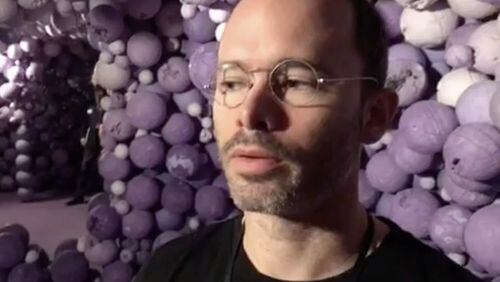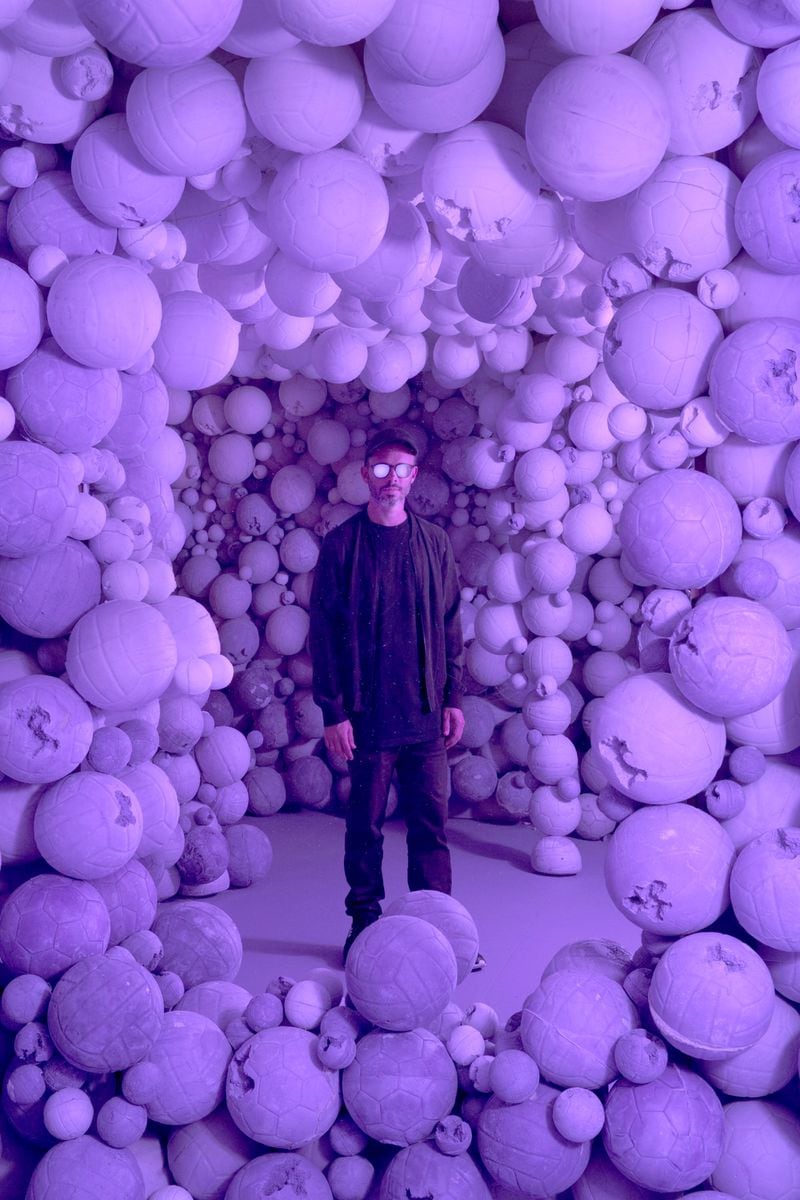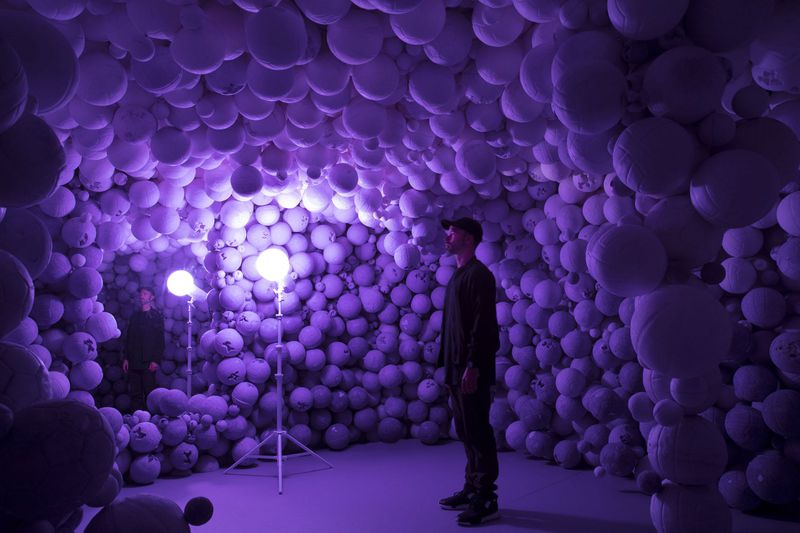Amethyst-encrusted spheres fill a room at the High Museum of Art, covering the walls and ceiling. They envelop a visitor like a giant's grape-flavored bubble bath.
Each basketball-sized globule is a different shade of purple, from light lavender to deep violet.
We can see the color differences. But artist Daniel Arsham cannot. Almost completely colorblind, his world is nearly monochromatic.
Arsham’s installation at the High, which opened to the public March 4, uses color dramatically, from the lilac cavern to the electric-blue tea-house in an adjoining room.
Why would Arsham create a blue Zen garden in a spectrum he can’t really see? (One might also ask: Why would he cast — in gypsum and amethyst — 2,000 spheres in the shapes of basketballs and volleyballs?
The work is called “Daniel Arsham: Hourglass,” and it includes a tableau of oversized hourglasses, which are turned to reveal “artifacts” from our era.
All are part of a series of creations called "Fictional Archaeologies." They imagine a scientist several thousand years in the future, examining the fossilized remains of, say, a Leica camera, a baseball, an X-Box controller. Arsham has cast those contemporary objects in imaginative materials — volcanic ash, gypsum, amethyst, pyrite, selenite.
The idea, said Arsham, is to take a present-day object and create a crumbling copy that looks like some fossil that future archaeologists might uncover. “They’ve been reformed in materials that we associate with the geological time frame,” said the slight 36-year-old as he helped direct the installation at the High.
Arsham is playing with time, and with familiar objects. But he is also creating a dramatic world. That has long been Arsham’s predilection.
The young man was born in Cleveland but grew up in Miami and studied art and architecture at Cooper Union in New York City. His architectural drawings were of buildings that appeared to be melting or waving in the wind. “They were somewhere between constructions and ruins — perfect ruins,” said Arsham, taking a break from the activity inside the Anne Cox Chambers Wing to sit in the cool sunshine of Sifly Piazza, just outside.
The choreographer Merce Cunningham took note of the young artist and in 2004 asked him to submit ideas for scenic designs to go along with a Cunningham dance performance. The two collaborated for years afterward.
Arsham has since created “scenography” for a variety of dramatic presentations, as well as interiors for clothing stores, and, through his architecture firm Snarkitecture, large-scale works, including an installation at the Florida Marlins ballpark in Miami.
His reputation for set design is what brought Arsham to Atlanta in the first place. On the other side of the Woodruff Arts Center campus, the Atlanta Symphony Orchestra had planned a return performance of Christopher Theofanidis’ sprawling oratorio, “Creation/Creator,” for March 23 and March 25, and were looking for an artist to create the scenery.
Evans Mirageas, vice president of artistic planning, asked the High’s contemporary art curator Michael Rooks for some suggestions, and Arsham was one of them. “I presented them to (music director) Robert Spano,” said Mirageas. “He looked at Daniel, and he said ‘That one.’”
Arsham will also create scenography for the ASO’s presentation of Christoph Willibald Gluck’s opera “Orfeo et Euridice,” to be performed May 11 and May 13.
But, on a recent Wednesday, concerns about the ASO were still in the future as Arsham battled the deadline before the opening at the High, answering questions from workers, intervening with lighting decisions, directing the color and placement of the pedestals for his hourglasses. “What’s going on with the sound?” he asked his assistant Meghan Clohessy, who answered that the tablet was getting “juiced up” and would soon be ready to play samples of the voice-over that will accompany the piece.
Arsham dealt with details. Would the dark marks on the concrete pedestals remain? Should there be live orchids, or just silk flowers in his garden? How should a round overhead light be hung to create the best shadows?
Known for his monochrome, black-and-white palette, Arsham began using brighter colors in his artwork after trying an experimental lens that allows color-blind people to experience colors. The lenses made by a company called EnChroma enhance the contrast of different colors.
Like the moment in “The Wizard of Oz” when the movie turns from black-and-white to color, the EnChroma glasses rocked Arsham’s world. In a documentary film about the experience, he puts the glasses on for the first time, and weeps.
But the glasses were no miracle cure.
“The more I wear these glasses, the more difficult it seems to imagine wearing them all the time,” he says, later in the documentary. “There were consequences that I hadn’t anticipated. It was almost like color fatigue.”
Now, he says, he uses the glasses as a tool, “to look at colors, and to know what you (the audience) should see, and then go back to my regular senses.”
EVENT PREVIEW.
'Daniel Arsham: Hourglass.' 10 a.m.-5 p.m., Tuesdays-Thursdays and Saturdays; 10 a.m.-9 p.m. Fridays; noon-5 p.m. Sundays; March 4-May 21; $14.50 (under 6: free); 1280 Peachtree St., N.E., Atlanta; www.high.org/
RELATED STORIES









